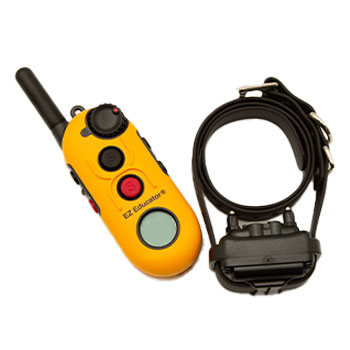Ed Frawley on Remote Collars vs. Animal Rights Extremists
A couple of weeks ago, Greg Van Curen and I made a humorous video about a very serious subject: using remote collars as a tool in dog training. You can view it at the bottom of the article.
I have always said that remote collars are one of the greatest dog training tools ever invented. They are also one of the most misunderstood dog training tools ever invented. Maybe Greg and I shouldn't have joked around about such a serious subject.
We felt that a little humor goes a long way in getting people to listen. In this case, it worked because we got over 750 shares and the video reached over 190,000 people.
t is important to us that what we say about training with remote collars is 100% accurate. The groups of people who are quick to speak out against remote collars don't take our position. They take the liberty to lean on emotion and misinformation.
Individuals who talk trash about remote collar training have never trained with a modern remote collar. These people are so outspoken, they have either witnessed collars being used incorrectly or are from the "all-positive training camp."
A couple of months ago, I wrote an article titled The Problem with All-Positive Dog Training. I won't revisit that subject here.
I am 67 years old and have been training dogs seriously for 50 years. I bought my first remote collar in the late 70's, a Tri-Tronics Pro100. I paid $1,000.00 for it. Remote collars back then were the Model T Fords of the day.
Those early remote collars put the "shock" in shock collars and the "electric" in electric collars. They gave remote collars a bad name because they were primitive tools.
My Pro100 only had 5 levels of stimulation. To change a level, I had to take the collar off the dog's neck and replace a plug on the receiver.
Back then there was no such thing as low-level stimulation training. Remote collars in the 70's and 80's were basically used to punish dogs for incorrect or bad behavior. The preferred method of training was to teach a dog how to turn off the stimulation through compliance. This could get ugly if the handler didn't know what he was doing. Heck, in my opinion, it was ugly even when the handler knew what he was doing.
I'll be honest, I tried it and I didn't like it. My timing was bad and I made too many mistakes. Too often, the level of stimulation would not be high enough to get a behavior change and the next higher level was too high for the dog, so I stopped using remote collars for many years.
I didn't start using them again until these new style of collars came out in 90's. This newer generation of remote collars allowed the stimulation level to be changed through a transmitter rather than on the collar sitting around the dog's neck.
Today's collars are like the Starship Enterprise compared to my old Pro100. Today we have collars that have tones, vibration modes, stimulation levels from 0 to 100 or 127, programmable buttons, and digital read-outs.
The new collars have resulted in the emergence of low-level stimulation training. We learned that when the remote collar is introduced correctly, many dogs, though not all, reacted to stimulation levels that humans can't even feel. We also learned that some dogs, just like some people, don't feel stimulation levels until much higher levels than other dogs feel.
This brings me back to the reason Greg Van Curen and I did the humorous video. We want to get out in front of the extremists in the animal rights movement who know very little about training dogs, much less about training with remote collars.
These people think the concept of a correction in training is to PUNISH a dog for non-compliance, when in fact, the purpose of a correction for any good dog trainer is to get a behavior change.
Animal rights extremists and/or all-positive dog trainers think of corrections as painful experiences. However, using a remote collar in a low-distraction environment with low-level taps simply translate into, "Hey, pay attention to me over here."
We also know there will be times when that same dog in a different environment--one with a higher level of distraction--is going to need a stronger level of correction before offering a behavior change.
The caveat here is that with repetition in training, those times will be less and less.
There are also times when bad behaviors need to be extinguished (i.e. chasing a squirrel or rabbit when off leash, etc.). For that to happen, those dogs will need a correction that is strong enough that the dog remembers the correction, and chooses to avoid that correction the next time it thinks about repeating that behavior.
I don't think Greg and I did a good enough job explaining that not every dog is going to respond to low levels of stimulation. One dog may respond at level 8 while another dog may not feel anything until level 30 or even 40. This does not mean that the dog is getting hurt at level 40. It simply means that's the level the dog starts to feel the stimulation from the collar.
I remember a Tri-Tronics seminar I went to in Winnipeg, Canada back in 1983 or 1984. The instructor passed a remote collar around and everyone put the collar on themselves. One of the students could barely feel the highest level on the palm of his hand. Everyone else could feel the first or second level.
The point is that every dog is different, just like every person is different. Many dogs react to stimulation levels humans can't feel but there are some dogs who don't feel stimulation until much higher levels.
That's why we can't tell new trainers they need to start training their dog at level 8 or level 10. They need to do the work to find out what level to start their training and do the conditioning correctly.
I recently got an email from a customer who said she has three dogs in training. Two of her dogs work perfectly on level 10 but she said her collar doesn't work on her third dog (a Boxer). She had taken the Boxer to level 30 and the dog acted like it wasn't even there. She thought the collar was broke, when in fact she needed to go to level 40 before the dog offered a behavior change.
This is just one of the reasons we need higher levels of stimulation on remote collars.
We also need higher levels of stimulation for emergencies, like when a dog is off-leash and starts to chase a cat or rabbit towards the street. Screaming "NO" at the dog may work, but if it doesn't, then it comes down to using a much higher level of stimulation to ensure the safety of your dog's life. I would much rather know I can save my dog's life everytime than risk it.
This brings me to the subject of dogs that verbalize when they get stimulated. Let's not kid ourselves. Training dogs with remote collars is avoidance training and corrections are an aversive.
If a dog is a screamer and it has not been properly conditioned to a remote collar, there is a good chance that the dog is going to be startled and verbalize (or yelp) when it gets stimulated at too high of a level.
Conditioning means the handler has determined the lowest level of stimulation his or her dog reacts to. It also means the handler has paired the collar to a leash correction and the dog understands that the correction is coming from the handler and not some unknown aberration in the environment.
When their conditioning is not done correctly, it is pretty common for dogs to have superstitious behavior associated with objects they are standing next to. They may think the tree or light pole or garbage can they are standing next to did something to them. The fact is, this doesn't happen when conditioning is done correctly and the collar is paired to the leash.
We cover this training in the collar videos I have produced.
With this said, to get a better understanding why some dog's startle, it helps to understand exactly how remote collar stimulation works.
Educator collars work exactly like a physical therapists TENS Unit. When therapists glues TENS pads on your body and then sends a current through the pads the current causes the muscles to contract. How much they contract depends on the level of current. Anyone who has had an injury and gone to a rehab therapy knows what this is. When it's done correctly it doesn't hurt at all, it just feels a little weird or strange.
When my son, Jeff, put a collar on his neck in our second video, he repeatedly increased the stimulation level to 100. We saw Jeff's neck muscles twitch but he didn't yelp because he knew what was going to happen. If that level was used on dogs that had not been properly conditioned to the collar, most dogs would verbalize because it startles the dog and they don't understand what's happening.
One of the goals of a good training program is to make sure the dog understands that the corrections come from the handler. When they understand that concept, they are less likely to have superstitious behavior associated with stimulations.
Unfortunately dog trainers in countries like Australia, New Zealand, and England never got out in front of the animal rights extremists and the all-positive dog trainers, which is why remote collars are banned in those countries.
We cannot allow this to happen in America, and that's why Greg and I made our video.
So if you are a dog trainer who is going to train with a remote collar, we strongly recommend that you put the collar on your neck or leg or your arm and go through the numbers until you feel it. Then go a little further so you know what you are working with.
If we can get dog trainers to post enough responsible videos on YouTube and their websites, we may change the minds of people who consider trying to get remote collars banned.
Remember the vast majority of the people who lobby against remote collars don't know anything about them. They hear the term ELECTRIC COLLAR or SHOCK COLLAR and they see a video of a collar being misused and they assume all collar training is abusive.









14 Comments
Ask Cindy
Sorry, adding comments is currently disabled.